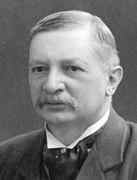Person: Rydberg, Johannes Robert

Johannes Robert Rydberg was a Swedish mathematician and physicist whose most important work was on spectroscopy.
Mathematical Profile (Excerpt):
- Now Rydberg had performed very well in all his school subjects but his favourite one had been mathematics so this was the major topic of his undergraduate studies.
- Rydberg received his bachelor's degree in 1875 from the University of Lund.
- While he was studying mathematics, Rydberg also taught physics at the Lund Physics Institute where he had been appointed as an assistant in 1876.
- In 1882 Rydberg moved from an assistant lectureship in mathematics to become an assistant lecturer in physics at the University of Lund.
- This new Institute would eventually become Rydberg's place of work for the rest of his career.
- In 1897 Rydberg applied for the chair of physics at the University of Lund which became vacant when Karl Albert Viktor Holmgren (1824-1905) retired.
- We look at the details of this, and in particular at the referee's assessment of Rydberg, in a separate article.
- After his appointment, Bäcklund tried to get Rydberg promoted to professor.
- In March 1901 Rydberg was named as an extraordinary professor but it only became a full professorial appointment in January 1909.
- Rydberg's most important work is on spectroscopy where he found a relatively simple expression relating the various lines in the spectra of the elements.
- Some of the features noted by Rydberg were observed about the same time by Kayser and Runge, but his work had the special merit of connecting different series in the spectrum of the same element into one system, which could be represented by a set of simple formulae having but few adjustable constants.
- He especially insisted that the hydrogen constant, now generally called the "Rydberg constant," should appear in all series and, apart from slight variations from element to element suggested by the theoretical work of Bohr, nearly all subsequent attempts to improve the representation series have involved this supposition, and have had Rydberg's formula as a basis.
- We now look at some of Rydberg's comments in these papers.
- We have seen above that Rydberg only became a full professor in 1909.
- Manne Siegbahn (1886-1978), who had been a student of Rydberg from 1906 to 1911, then Rydberg's assistant from 1911 to 1914, took over his teaching duties in 1914.
- He carried these out until Rydberg reached the age of 65 in 1919.
- Rydberg resigned his position in 1915 and in 1916 he was taken into hospital.
- Siegbahn became a professor in 1915 when Rydberg retired but it was only early in 1920 that he was appointed to Rydberg's chair of physics.
- For years chairman of the 'Fysiska föreningen' in Lund, Rydberg was always interested in discussions with the younger men in the society and the institution, and with graduate students nearing their goal.
- We have already seen that, despite his groundbreaking work, Rydberg struggled to get a professorial appointment.
- The crater Rydberg on the Moon and asteroid 10506 Rydberg have been named in his honour.
Born 8 November 1854, Halmstad, Sweden. Died 28 December 1919, Lund, Sweden.
View full biography at MacTutor
Tags relevant for this person:
Origin Sweden
Thank you to the contributors under CC BY-SA 4.0! 

- Github:
-

- non-Github:
- @J-J-O'Connor
- @E-F-Robertson
References
Adapted from other CC BY-SA 4.0 Sources:
- O’Connor, John J; Robertson, Edmund F: MacTutor History of Mathematics Archive
